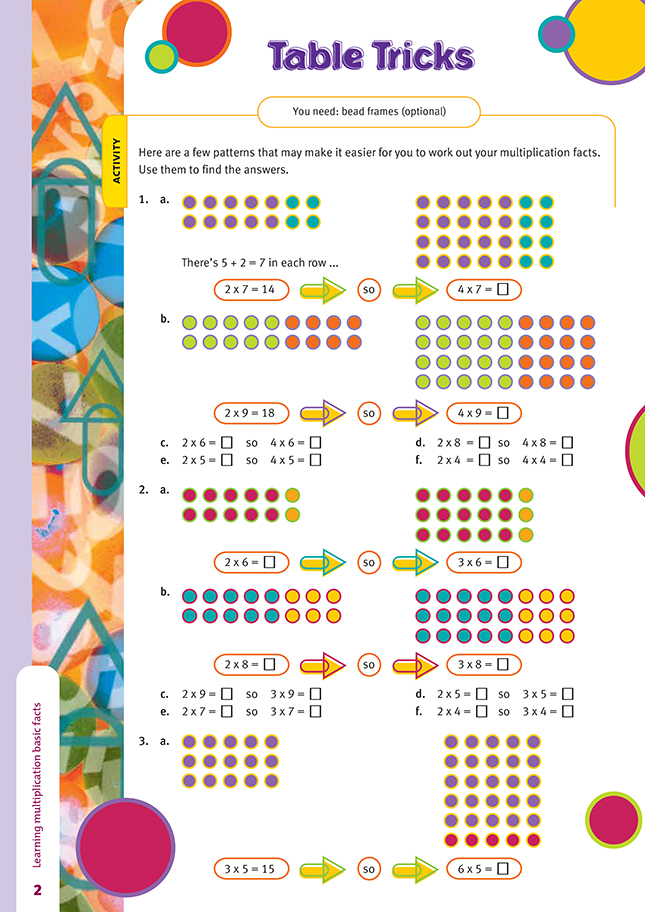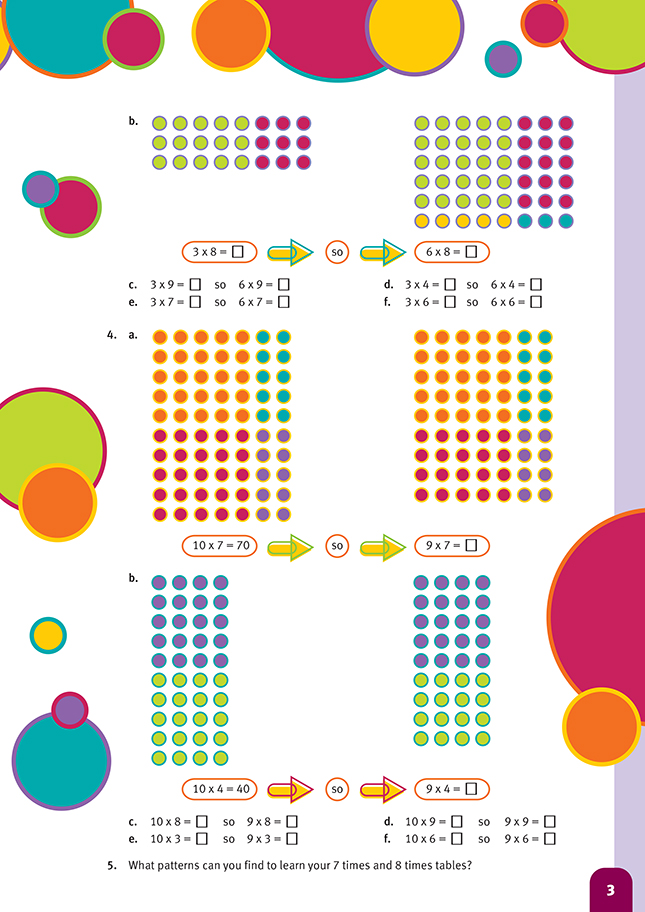This is a level 3 number link activity from the Figure It Out series. It relates to Stage 6 of the Number Framework.
A PDF of the student activity is included.
Click on the image to enlarge it. Click again to close. Download PDF (208 KB)
investigate patterns in multiplication facts
FIO, Link, Number, Book Two, Table Tricks, pages 2-3
Bead frames (optional)
Each question in this activity encourages students to look within the array and partition it in such a way that they can easily find the answer. For example, 7 x 2 can be seen as the same as 5 x 2 plus 2 x 2, so a student who doesn’t already know the answer can use this idea to work it out. You might also need to explain to those students who already know that 7 x 2 = 14 that partitioning is an easy way to confirm an answer.
Each question contains a pair of related equations. This encourages the students to see a connection between the two parts of the question and to use this to find the answer. Some students may find this hard to do at first, but it’s a great way to improve their thinking skills. Many students are so used to treating each calculation
as a separate question that they may feel strange using one question to solve another. Keep encouraging them by asking them to look for the things that are the same and the things that are different in the pairs of equations. Ask them how they could use the sameness and differences to work out the answer. For example, in question 1, they will see that the difference is that the “2” rows have become “4”. The 2 has been doubled, so the answer must be doubled because everything else is the same.
The end result of using these patterns and connections is that students will develop an intuitive feel for the distributive property of multiplication and division as well as learning their facts.
Students who find the dot arrays too simple could use the same thinking to multiply larger numbers, for example, 15 x 8 = 120, so 15 x 16 = . The students could extend this thinking further by using it in related division problems. For example, 15 ÷ 5 = 3, so 30 ÷ 5 = or 120 ÷ 15 = 8, so 240 ÷ 15 = .
Answers to Activity
1. a. 2 x 7 = 14, so 4 x 7 = 28 (or double 14 to get 28)
b. 2 x 9 = 18, so 4 x 9 = 36. (18 + 18 = 36)
c. 2 x 6 = 12, so 4 x 6 = 24. (12 + 12 = 24)
d. 2 x 8 = 16, so 4 x 8 = 32. (16 + 16 = 32)
e. 2 x 5 = 10, so 4 x 5 = 20. (10 + 10 = 20)
f. 2 x 4 = 8, so 4 x 4 = 16. (8 + 8 = 16)
2. a. 2 x 6 = 12, so 3 x 6 = 18. (12 + 6 = 18)
b. 2 x 8 = 16, so 3 x 8 = 24. (16 + 8 = 24)
c. 2 x 9 = 18, so 3 x 9 = 27. (18 + 9 = 27)
d. 2 x 5 = 10, so 3 x 5 = 15. (10 + 5 = 15)
e. 2 x 7 = 14, so 3 x 7 = 21. (14 + 7 = 21)
f. 2 x 4 = 8, so 3 x 4 = 12. (8 + 4 = 12)
3. a. 3 x 5 = 15, so 6 x 5 = 30. (15 + 15 = 30)
b. 3 x 8 = 24, so 6 x 8 = 48. (24 + 24 = 48)
c. 3 x 9 = 27, so 6 x 9 = 54. (27 + 27 = 54)
d. 3 x 4 = 12, so 6 x 4 = 24. (12 + 12 = 24)
e. 3 x 7 = 21, so 6 x 7 = 42. (21 + 21 = 42)
f. 3 x 6 = 18, so 6 x 6 = 36. (18 + 18 = 36)
4. a. 10 x 7 = 70, so 9 x 7 = 63. (70 – 7 = 63)
b. 10 x 4 = 40, so 9 x 4 = 36. (40 – 4 = 36)
c. 10 x 8 = 80, so 9 x 8 = 72. (80 – 8 = 72)
d. 10 x 9 = 90, so 9 x 9 = 81. (90 – 9 = 81)
e. 10 x 3 = 30, so 9 x 3 = 27. (30 – 3 = 27)
f. 10 x 6 = 60, so 9 x 6 = 54. (60 – 6 = 54)
5. Answers may vary. The 7 times table is the
5 times table plus the 2 times table.
For example: 7 x 8 = (5 x 8) + (2 x 8)
= 40 + 16
= 56
The 8 times table is twice the 4 times table.
For example: 4 x 6 = 24, so 8 x 6 = 48

